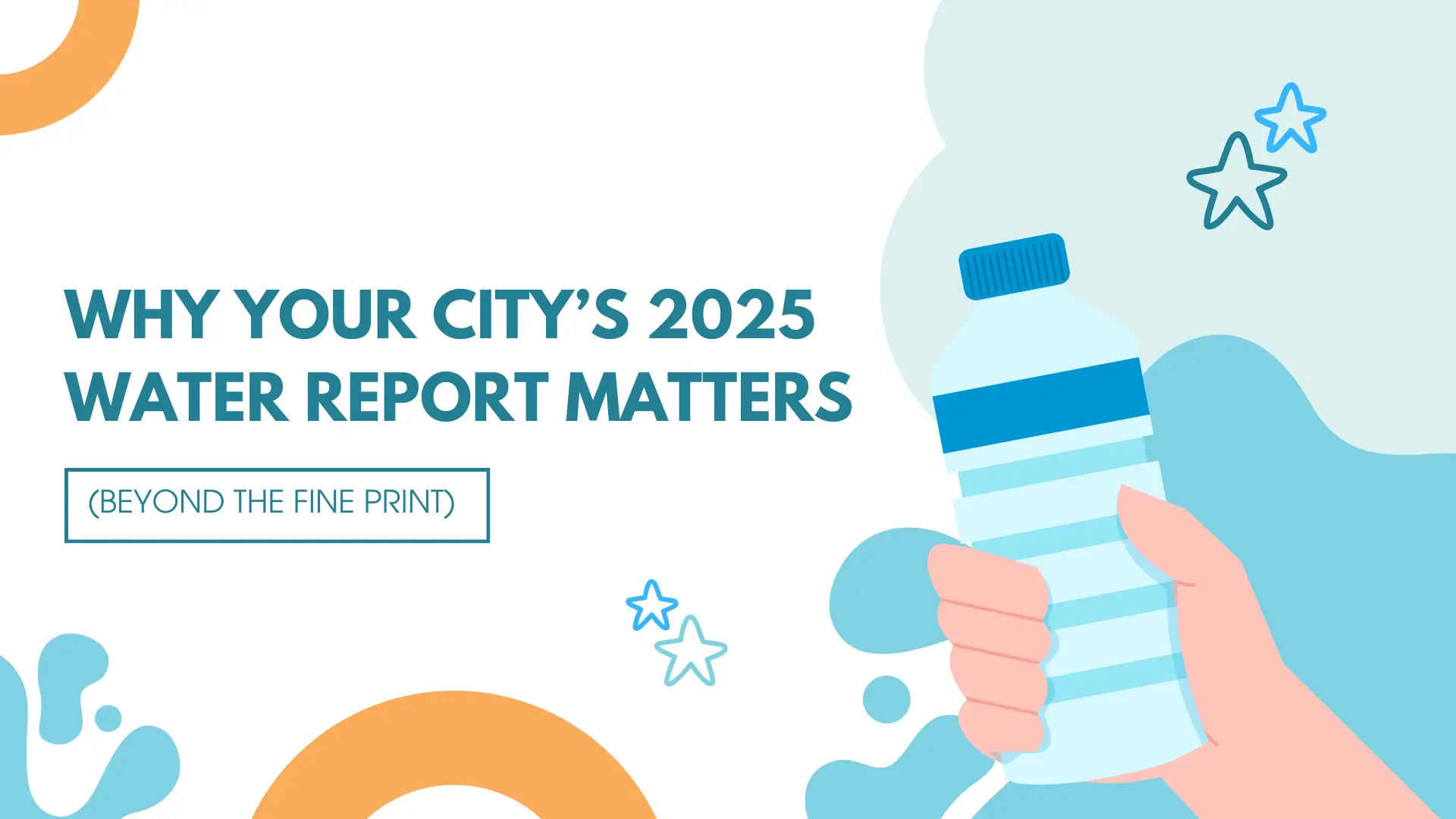Each summer, municipal water providers in Texas publish their Consumer Confidence Report (CCR), also known as the annual water quality or drinking water report. In 2025, these reports carry more weight than ever: new federal limits for PFAS (so-called “forever chemicals”) are taking effect, and Texas utilities are under pressure to show compliance.
Reading that 10- or 20-page report isn’t just about compliance. You want to know: is your tap delivering more than just water? Is it stressing your plumbing, appliances, or even your body? This guide walks you through how to read your city’s 2025 water report, spot real concerns, and take action where it matters.
What’s Inside a 2025 Texas Water Report — and What To Watch For
Texas public water systems test for 102 regulated contaminants (inorganics, disinfectants, microbial sources, etc.) each year and must report them. But the report isn’t just a laundry list of chemicals. Key sections include:
- Water source and treatment (Where your water comes from—river, reservoir, aquifer)
- Detected contaminants (with min, max, and average levels)
- Compliance status (any violations)
- Health information (who might be more at risk)
- Supplemental information (aesthetic issues: taste, odor, hardness)
As you read, keep your city in mind. For example: Dallas detected 38 contaminants in recent data; 17 of them were above guidelines that independent groups (like EWG) consider unsafe. Meanwhile, dozens of Texas systems have reported PFAS levels exceeding new federal limits. Use those real local cases as guardrails when you examine your own report.
Common Contaminants in Texas (and Why They Matter to You)
Texas geology and human activity combine to produce a few troublemakers that tend to recur in CCRs. Knowing which ones are common helps you interpret what your city’s numbers might imply.
Elevated Minerals / Hard Water
Many Texas water systems deliver “moderately hard” to “very hard” water. Dissolved calcium and magnesium leave scale on fixtures and chips away at water heaters and appliances. You might see: cloudy glassware, ring around sinks, soap that doesn’t lather, or clogged showerheads.
Disinfection Compounds & Byproducts
To kill pathogens, water utilities add chlorine or chloramines. But when they disinfect water that contains organic matter, they can produce disinfection byproducts (like trihalomethanes and haloacetic acids). In Dallas, many contaminants above safe guidelines were from disinfection byproducts. These don’t always smell or taste bad — but they pose long-term risks.
PFAS (“Forever Chemicals”)
Texas is already seeing public water systems exceed the new enforceable PFAS levels (for PFOA and PFOS). These compounds resist breakdown and accumulate in the body; chronic exposure has been linked to immune disruption, liver damage, developmental issues, and certain cancers.
Heavy Metals, Nitrate, Arsenic, Others
Depending on your region, your water might also carry lead (from old plumbing), arsenic, nitrate (especially near agricultural zones or high fertilizer use), or volatile organic compounds (VOCs). For example, Dallas’s report showed nitrate levels nearly five times a “health-based” guideline in independent analyses.
Microbial Indicators & Turbidity
Though fewer reports show serious bacterial contamination (if water systems are functioning), the report will usually include coliform/E. coli results. Cloudy water or spikes in turbidity readings can signal infiltration or treatment breakdown.
How to Decode Your Report — Section by Section
Here’s how a friendly neighbor who also knows chemistry would read it. (You can do this too — no PhD needed.)
1. Look at the Source & Treatment Description First
If your water is drawn from surface sources (rivers, lakes), it may carry more organic material and runoff contaminants. If it’s from deep aquifers, you might see high mineral content. This context helps interpret why certain numbers are high.
2. Focus on “Detected Contaminants” — Especially Those with Health Limits
In the CCR, find contaminants where the maximum or average approaches or exceeds regulatory limits (MCLs). For 2025 reports, check PFAS (especially PFOA, PFOS), lead, arsenic, nitrates, and disinfection byproducts. If any violations are listed, those are red flags.
3. Compare Aesthetic/Secondary Figures
Secondary parameters aren’t regulated for health but affect your daily experience: hardness, pH, iron, manganese, color, taste, odor. High values here won’t poison you (usually) — but they ruin your espresso maker, irritate your skin, and shorten the life of your plumbing.
4. Check for Any Violations or “Notices to Customers”
Your city has to flag violations if test averages go beyond legal limits. That tells you whether their system is struggling. Also, some cities will include special notes, like “PFAS results forthcoming” or “additional monitoring in progress.”
5. Read the Footnotes and Sampling Periods
Sometimes the “max” value is because of one outlier. Check how many samples were taken, the period, and whether that contaminant is trending upward or stable. If your water provider tested only quarterly or changed labs, that matters.
6. Cross-Check With Independent Watchdogs
Sites like EWG, or local water advocacy groups, interpret CCRs independently—sometimes using stricter “health benchmarks.” For instance, Dallas’s CCR passed federal rules, but independent analyses flagged several exceedance points. Use those overlays as sanity checks.
When You Spot Worrisome Numbers: What You Can Do
If your city’s annual report throws up red flags (or even if it’s all “within limits”), you’ve got options.
Test Locally at Your Tap
Utility reports represent averages across large distribution networks—your home could have added contamination (lead from pipes, biofilms, infiltration). Use:
- DIY test kits (for pH, TDS, hardness, iron)
- Digital meters (for TDS, EC)
- Accredited labs (for PFAS, heavy metals, VOCs)
Once you know what’s in your water at your faucet, you can choose effective defense.
Tailored Solutions
Here’s where Aquapure’s name comes in—not as hail-talk, but as part of the toolbox.
- To fight scale and hardness, a custom water softener (ion exchange or salt-free) makes sense. Aquapure offers free installation and support, lifetime warranty, and flexible financing ($0 down).
- For chemical contamination (chlorine, VOCs, PFAS), a filter system (activated carbon, specialty media, reverse osmosis) at point-of-entry or under-sink helps. Aquapure also designs home filtration systems tailored to your test results, backed by certified technician installation and support.
- For microbial risk (if your CCR shows bacterial issues or in private wells), add UV disinfection or validate with repeated testing.
The point: pick what solves your report’s risks, not a generic “one size fits all.” The fact that Aquapure is Texas-owned, family-operated, and has served for 10+ years means they’re closer to your concerns.
Maintain & Re-Test
Filters and media saturate. Softening resin ages. Every 12–24 months (or sooner for PFAS/lead), retest and refresh your system. If your city report shows trends (rising PFAS, new disinfection byproducts), stay alert.
Local Perspective: What 2025 Said for Texas Cities
- San Antonio / SAWS reports draw from multiple aquifers (Edwards, Carrizo, Trinity, Wilcox). SAWS is actively monitoring PFAS; one Castle Hills well did test positive (but not over the new limit).
- Dallas Water Utility had 38 detected contaminants; 17 exceed EWG’s health benchmarks—including PFAS, nitrates, chromium-6, and disinfection byproducts.
- North Texas (NTMWD) publishes frequent testing and classifies its water “moderately hard,” with the main issue being scale rather than acute health risk.
- Many Texas systems are already reporting or preparing for PFAS compliance challenges: 49 utilities across the state have reported exceeding new PFAS levels.
Your city’s situation may resemble one of those patterns. Use the cases as benchmarks: “If Dallas shows chromium-6 troubles, is ours similar?” Use that context when you interpret your own report.
Local FAQs (For Texas Homeowners)
Is Katy’s tap water safe to drink?
Yes, the municipal system generally meets federal safety standards (e.g. “Superior” rating in many reports). But “safe” means “meets legal limits” — it doesn’t guarantee minimal contamination or that your home plumbing hasn’t added something.
Do I need a water softener in Katy?
Probably. Many parts of greater Houston / Katy area experience moderately hard water. You’ll benefit from scale control, better appliance efficiency, and reduced repair costs.
How much does testing and installing systems cost in Texas?
- Basic test kits or strips: ~$10–30
- A lab panel for heavy metals/PFAS: $50–200+
- Whole-house softener + installation: $1,000–3,000 (depending on home size, hardness level)
- Filtration + RO add-ons: $1,500–4,000+
Aquapure’s $0 down / financing option helps smooth that expense curve, and lifetime warranty brings long-term peace of mind.
If my city report shows no violations, do I still need a personal system?
Yes. The CCR reflects regulation thresholds and system-wide averages. It doesn’t account for your plumbing, lead pipes, or emerging contaminants that weren’t tested or regulated in the past.
How often should I read my city’s water report and retest my own water?
Read your city’s report every year (usually released by July). Retest your tap water every 1–3 years (or more frequently if issues appear). For PFAS/lead, consider every 2–5 years.
Final Thoughts: Don’t Just Scan — Understand & Act
Your city’s 2025 water report is not bedtime reading — it’s a map. Read it with curiosity and healthy skepticism. Use the numbers and contaminant calls as clues to whether you should walk over to your water heater, check your pipes, install a filtration stage, or call a pro.
If you’d like help deciphering your specific city’s 2025 report (Dallas? Austin? Houston? San Antonio?) I can walk you line-by-line. And if you decide a custom treatment system is needed, requesting a free Aquapure water test or quote might be the smartest next step.
Water shapes our daily life—your home deserves that level of care.



